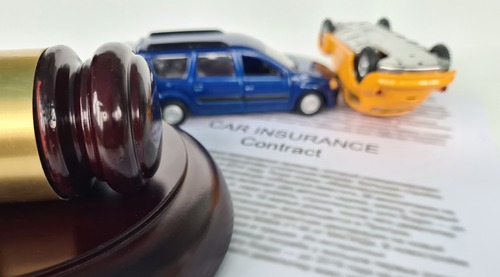At Atlanta Metro Law, we focus on helping people who have been injured in car accidents and other personal injury cases across Georgia. We know how hard it can be to deal with insurance companies, medical bills, and the stress that follows a serious accident. That’s why we fight to make sure our clients get the fair compensation they deserve. If you’ve been hurt and need answers, we’re here to help you every step of the way.
If you are injured in a Georgia car accident, understanding how Georgia comparative negligence laws work is critical to protecting your right to recover compensation. Georgia follows a modified comparative negligence system, meaning that fault assigned to each driver will affect the amount of damages awarded. If you are found partially at fault, your compensation may be reduced or denied if you are 50% or more responsible.
In this blog, we explain how Georgia comparative negligence laws affect car accident claims, how fault is determined, and why working with an experienced Atlanta car accident attorney is important to protect your right to fair compensation.
What is Comparative Negligence?
Understanding comparative negligence is essential for anyone involved in a Georgia car accident. This section explains what Georgia comparative negligence laws mean and how it affects personal injury claims under Georgia law.
Definition of Comparative Negligence
Comparative negligence is a legal rule used to determine fault in personal injury cases. It applies when multiple parties share responsibility for an accident. Instead of assigning full blame to one party, the law divides fault between everyone involved. Each party’s percentage of fault affects how much they can recover in damages. If an injured party is partly responsible, their final compensation will be reduced by their share of fault.
Comparative Negligence vs. Contributory Negligence
Some states follow contributory negligence, which prevents a person from recovering any damages if they share any fault for an accident. Georgia does not follow contributory negligence. Instead, Georgia follows modified comparative negligence, which is more favorable to accident victims. Under Georgia comparative negligence laws, an injured person can still recover compensation if they are less than 50% at fault.
Modified Comparative Negligence State
Georgia is a modified comparative negligence state. This means an injured person can only claim compensation if their share of fault is less than 50%. If a court finds that an injured party is 50% or more responsible, they cannot recover damages. This system aims to ensure fair compensation based on each party’s role in causing the accident.
Why Comparative Negligence Matters in Car Accident Cases
Understanding Georgia comparative negligence laws helps accident victims know what to expect when seeking compensation for medical expenses, lost wages, and pain and suffering. It also affects settlement negotiations with insurance companies. Knowing how fault is assigned can help a person protect their rights and fight for a fair settlement.
How Georgia Comparative Negligence Laws Work
Understanding how Georgia comparative negligence laws work is important for anyone involved in a car accident case. This section explains the rule and how it affects personal injury claims and compensation.
The 50% Bar Rule
Georgia comparative negligence laws are modified with a 50% bar rule. This means an injured party can only recover damages if they are found less than 50% at fault for the accident. If an injured person is 50% or more responsible, they cannot claim compensation from the other party. This rule applies to car accident cases, personal injury cases, and wrongful death claims.
How Fault Percentage Affects Compensation
If an injured person is partially at fault, their final compensation is reduced by their percentage of fault. For example, if a driver is found 20% at fault and their total damages are $100,000, they will receive $80,000. The other driver’s insurance company is responsible for paying this reduced amount. This system reflects each party’s role in causing the accident and ensures that no one recovers damages for harm they caused themselves.
Example of Modified Comparative Negligence in Action
Consider a car accident involving two drivers. Driver A is speeding. Driver B runs a stop sign. A jury finds Driver A 40% at fault and Driver B 60% at fault. Since Driver A’s fault is less than 50%, Driver A can recover compensation, but reduced by 40%. Driver B cannot recover damages because their fault exceeds 50%. This is how Georgia comparative negligence laws work in practice.
Why This Rule Matters for Personal Injury Claims
The 50% bar rule can significantly affect an injured party’s ability to recover compensation. Insurance adjusters and insurance companies often argue about fault to reduce payouts. Understanding how modified comparative fault works helps accident victims fight for a fair settlement and avoid losing the right to claim compensation. Personal injury attorneys play a key role in challenging unfair fault assigned by insurers.
Determining Fault in Georgia Car Accident Cases
Determining fault in Georgia car accident cases is critical because it affects how much compensation an injured party can recover.
Legal Duty and Reasonable Care
Every driver in Georgia has a legal duty to exercise reasonable care on the road. This means following traffic laws, driving safely, and avoiding actions that could harm others. When a driver breaks this duty, by speeding, distracted driving, or running a red light, they may be found negligent. Proving that a driver failed to exercise reasonable care is the first step in establishing negligence.
Evidence Used to Establish Negligence
To prove negligence, an injured party must show that another driver caused the accident. Sufficient evidence is needed to support this claim. Key types of evidence include:
- Police reports that describe the accident and who may be at fault.
- Medical records that show the extent of injuries.
- Photos of the accident scene, vehicles, and injuries.
- Witness statements from people who saw the accident.
- Traffic camera footage if available.
This evidence helps show how the accident happened and who was responsible.
Role of Insurance Companies and Adjusters
Insurance adjusters review the evidence to decide who is at fault. They may try to argue that the injured person shares some blame to reduce how much the insurance company pays. This is why it is important to gather strong evidence to protect against unfair fault assigned. Adjusters will look at police reports, statements, and other documents to make their decisions.
Multiple Parties Sharing Responsibility
In some car accident cases, multiple parties share responsibility. For example, one driver may have been texting while another ran a stop sign. Georgia comparative negligence laws allow fault to be divided between all parties. Each party’s percentage of fault affects how much they can recover. If an injured party is less than 50% at fault, they can still recover damages, reduced by their share of responsibility.
Why Determining Fault Matters
Knowing how fault is determined is important because it affects the amount of compensation awarded. If an injured person is found partially at fault, their final compensation will be lower. If they are found 50% or more at fault, they cannot claim compensation. A personal injury lawyer can help gather sufficient evidence, challenge unfair fault assessments, and ensure a fair settlement.
Get Legal Guidance From Car Accident Attorneys at Atlanta Metro Law!
If you were injured in a Georgia car accident and are facing questions about fault or comparative negligence, our team at Atlanta Metro Law is ready to help. We fight to protect your rights and pursue the full compensation you deserve.
Contact us at 864-894-2045 for a free case consultation today!





